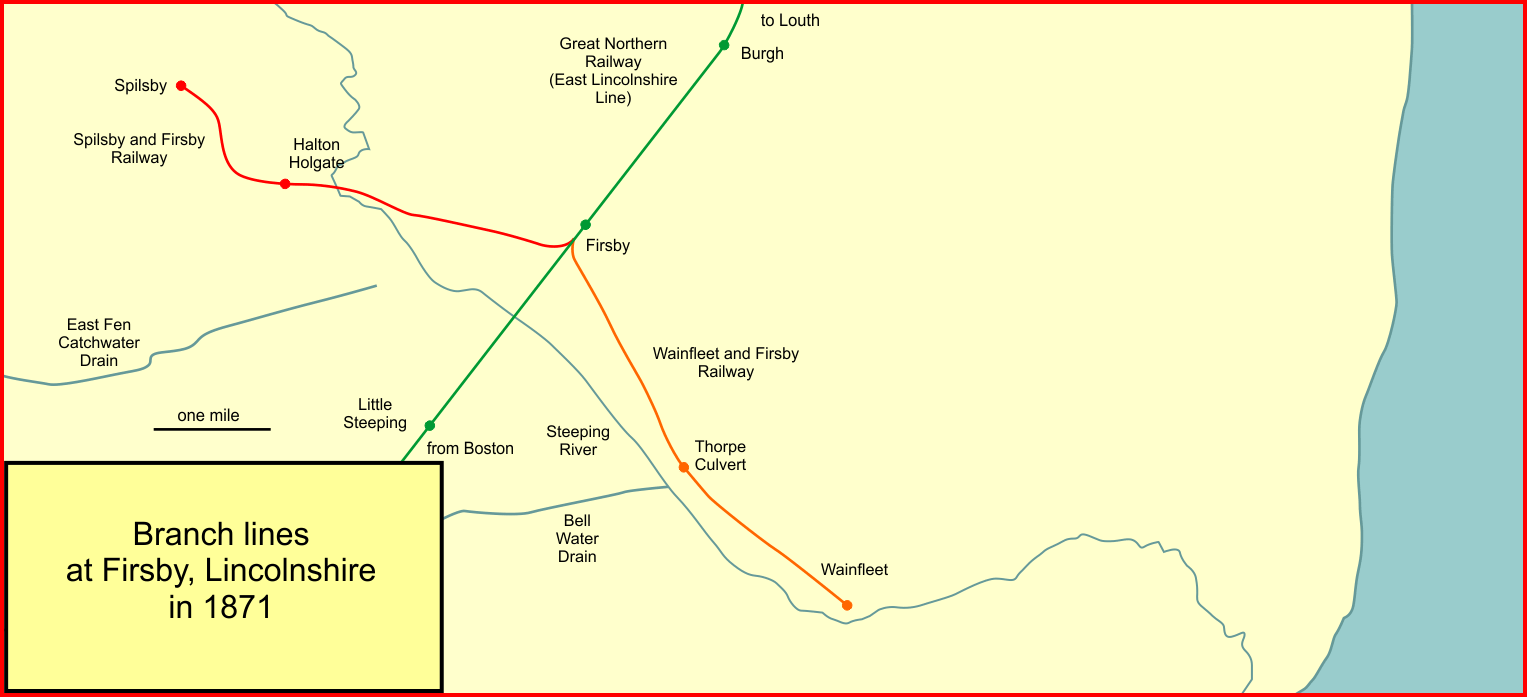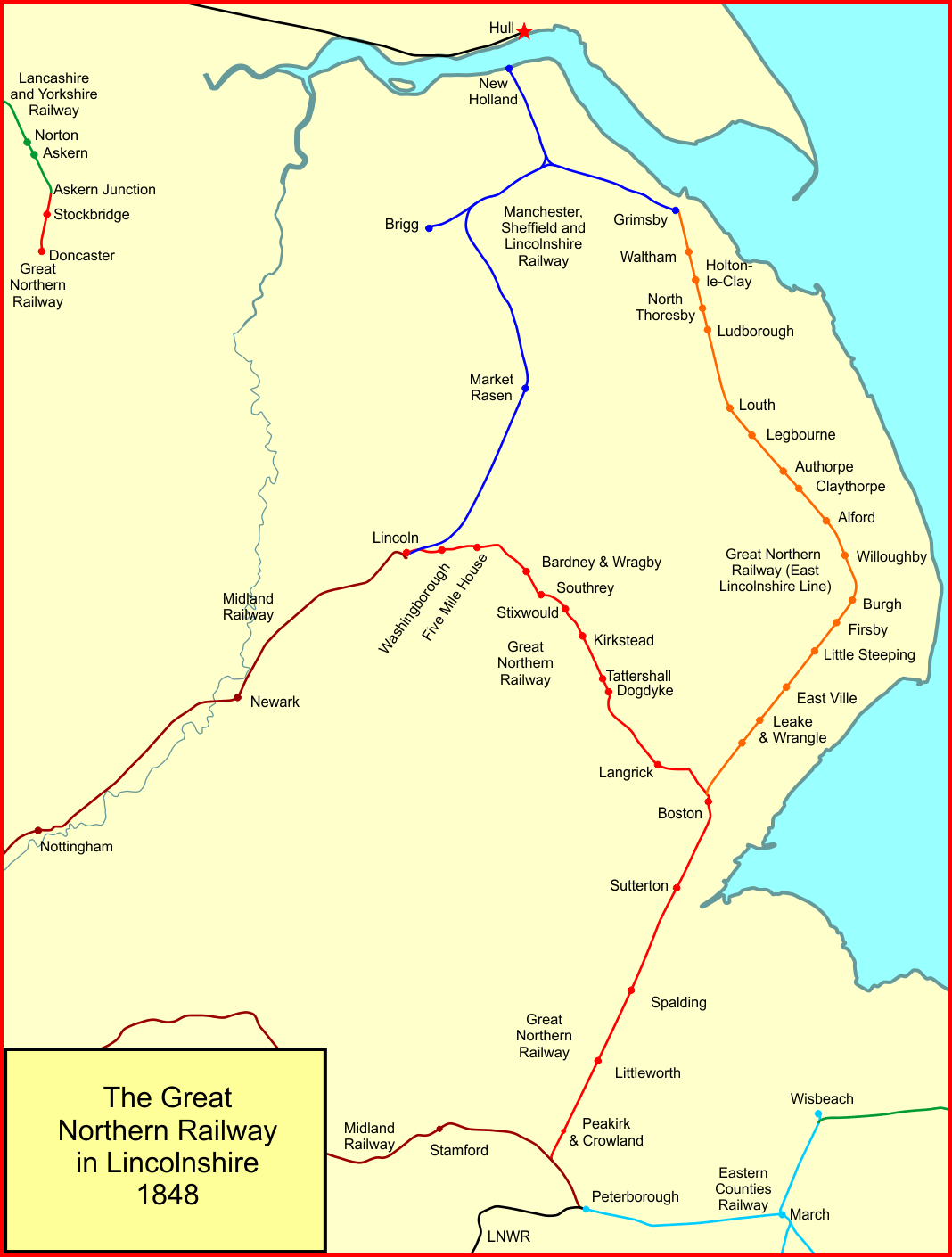|
Spilsby Branch
The Spilsby branch was a railway line built in Lincolnshire, England by the Spilsby and Firsby Railway Company. It was made to connect the market town of Spilsby with the main line network. It opened in 1868, and was worked by the Great Northern Railway. The Company was never financially successful, and its proprietors sold it to the Great Northern Railway in 1891. The passenger service was withdrawn as an economy measure on the outbreak of World War II in 1939 and never reinstated, and the line closed completely in 1958. Beginning In the early decades of the nineteenth century, Spilsby was a thriving market town. However when the Great Northern Railway opened the East Lincolnshire Line, the line passed some distance from Spilsby. Towns that were directly served by the new railways developed commercially, and Spilsby declined. A meeting at Spilsby in 1864 agreed that a branch line was the solution, and on 5 July 1865 the Spilsby and Firsby Railway Company was authorised.Paul An ... [...More Info...] [...Related Items...] OR: [Wikipedia] [Google] [Baidu] |
Lincolnshire
Lincolnshire (abbreviated Lincs.) is a county in the East Midlands of England, with a long coastline on the North Sea to the east. It borders Norfolk to the south-east, Cambridgeshire to the south, Rutland to the south-west, Leicestershire and Nottinghamshire to the west, South Yorkshire to the north-west, and the East Riding of Yorkshire to the north. It also borders Northamptonshire in the south for just , England's shortest county boundary. The county town is Lincoln, where the county council is also based. The ceremonial county of Lincolnshire consists of the non-metropolitan county of Lincolnshire and the area covered by the unitary authorities of North Lincolnshire and North East Lincolnshire. Part of the ceremonial county is in the Yorkshire and the Humber region of England, and most is in the East Midlands region. The county is the second-largest of the English ceremonial counties and one that is predominantly agricultural in land use. The county is fou ... [...More Info...] [...Related Items...] OR: [Wikipedia] [Google] [Baidu] |
Spilsby
Spilsby is a market town, civil parish and electoral ward in the East Lindsey district of Lincolnshire, England. The town is adjacent to the main A16, east of the county town of Lincoln, north-east of Boston and north-west of Skegness. It lies at the southern edge of the Lincolnshire Wolds and north of the Fenlands, and is surrounded by scenic walking, nature reserves and other places to visit. The town has been a rural market town for more than 700 years. It has changed little in size since the beginning of the 19th century. The town centre includes a range of small supermarkets, banks, traditional newsagents, baker, butchers, jewellers and clothing stores, together with public houses, cafes and fast-food takeaways. At the centre of town is an open square or traditional market place, from which the four main town streets radiate. Markets take place on a Monday. As Spilsby is located within a predominantly agricultural area, much of the market produce consists of lo ... [...More Info...] [...Related Items...] OR: [Wikipedia] [Google] [Baidu] |
Great Northern Railway (Great Britain)
The Great Northern Railway (GNR) was a British railway company incorporated in 1846 with the object of building a line from London to York. It quickly saw that seizing control of territory was key to development, and it acquired, or took leases of, many local railways, whether actually built or not. In so doing, it overextended itself financially. Nevertheless, it succeeded in reaching into the coalfields of Nottinghamshire, Derbyshire and Yorkshire, as well as establishing dominance in Lincolnshire and north London. Bringing coal south to London was dominant, but general agricultural business, and short- and long-distance passenger traffic, were important activities too. Its fast passenger express trains captured the public imagination, and its Chief Mechanical Engineer Nigel Gresley became a celebrity. Anglo-Scottish travel on the East Coast Main Line became commercially important; the GNR controlled the line from London to Doncaster and allied itself with the North Easte ... [...More Info...] [...Related Items...] OR: [Wikipedia] [Google] [Baidu] |
World War II
World War II or the Second World War, often abbreviated as WWII or WW2, was a world war that lasted from 1939 to 1945. It involved the World War II by country, vast majority of the world's countries—including all of the great powers—forming two opposing military alliances: the Allies of World War II, Allies and the Axis powers. World War II was a total war that directly involved more than 100 million Military personnel, personnel from more than 30 countries. The major participants in the war threw their entire economic, industrial, and scientific capabilities behind the war effort, blurring the distinction between civilian and military resources. Air warfare of World War II, Aircraft played a major role in the conflict, enabling the strategic bombing of population centres and deploying the Atomic bombings of Hiroshima and Nagasaki, only two nuclear weapons ever used in war. World War II was by far the List of wars by death toll, deadliest conflict in hu ... [...More Info...] [...Related Items...] OR: [Wikipedia] [Google] [Baidu] |
Firsby Lines 1871
Firsby is a small rural linear village and civil parish in the East Lindsey district of Lincolnshire, England. It is situated east from the city and county town of Lincoln, south-east from the nearest market town of Spilsby, and inland from the holiday resort town of Skegness. The village lies on the northern side of the waterway today known as the Steeping River, which is the lower element of the River Lymn that sources in the Lincolnshire Wolds. Firsby was once the location of one of the busiest railway stations on the East Coast of England. The 2001 Census recorded a village population of 276, increasing slightly at the 2011 census to 278. History Early history Historically Firsby belonged to the Wold division of the Wapentake of Candleshoe and was in a part of ancient Lindsey. In his ''History of the County of Lincolnshire'' written in 1834, historian Thomas Allen records "Firsby is an obscure place on the north side of the River Limb (sic) between Wainfleet ... [...More Info...] [...Related Items...] OR: [Wikipedia] [Google] [Baidu] |
East Lincolnshire Railway
The East Lincolnshire Railway was a main line railway linking the towns of Boston, Louth and Grimsby in Lincolnshire, England. It opened in 1848. The ELR ''Company'' had leased the line to the Great Northern Railway, and it was the latter which constructed the line and operated it, as its East Lincolnshire Line. As the Great Northern Railway completed its network, the East Lincolnshire Line formed a main line to Louth and Grimsby. In the latter decades of the nineteenth century seaside leisure pursuits became important, and the line became the trunk route supporting branches to Skegness, Sutton on Sea and Mablethorpe. Agricultural produce was important throughout the life of the line. As road transport became more convenient, the line lost custom, and in 1970 it closed except for the portion from Boston to Firsby, which supported the Skegness branch, which continued in use. All intermediate stations on the ELR, and all of the route from Firsby to Grimsby were closed to passeng ... [...More Info...] [...Related Items...] OR: [Wikipedia] [Google] [Baidu] |
Spilsby Railway Station
Spilsby railway station was a railway station in the market town of Spilsby, Lincolnshire, England. The station stood on a four mile long branch line between Spilsby and Firsby Junction, where it connected with the main line from Cleethorpes to London London is the capital and largest city of England and the United Kingdom, with a population of just under 9 million. It stands on the River Thames in south-east England at the head of a estuary down to the North Sea, and has been a majo ..., and was opened on 1 May 1868. However, traffic on the line soon slumped, and the line was bought by the Great Northern Railway in 1890. In 1939 passenger services on the line were suspended, leaving only a goods service which itself ceased in 1958, when the railway station and line were closed.British Railways Atlas.1947. p.17 References Further reading Ludlam, A.J. (1985). The Spilsby to Firsby Railway: Oakwood Press. External links Spilsby station on navigable 1947 ... [...More Info...] [...Related Items...] OR: [Wikipedia] [Google] [Baidu] |
Lincolnshire Lines Of The Great Northern Railway
The Lincolnshire lines of the Great Northern Railway are the railways, past and present, in the English county built or operated by the Great Northern Railway. The Great Northern Railway was authorised in 1846 and was to build from London to York via Newark and also a "Loop Line" via Lincoln. The GNR leased and operated the East Lincolnshire Railway. The construction proceeded in stages, and the line from Peterborough through Boston to Lincoln opened in 1848. The East Lincolnshire Railway from Boston to Grimsby opened in the same year. Gradually the GNR filled in the space between the Loop Line and the coast. East-west connections were developed, and holiday and excursion traffic proved a huge development. The haulage of coal from the Nottinghamshire and Yorkshire coalfields to London and East Anglia was a lucrative traffic. There was relatively little competition from rival railways in the area, and the network as a whole was successful. However the rural character of many of t ... [...More Info...] [...Related Items...] OR: [Wikipedia] [Google] [Baidu] |
Railway Lines Opened In 1868
Rail transport (also known as train transport) is a means of transport that transfers passengers and goods on wheeled vehicles running on rails, which are incorporated in tracks. In contrast to road transport, where the vehicles run on a prepared flat surface, rail vehicles (rolling stock) are directionally guided by the tracks on which they run. Tracks usually consist of steel rails, installed on sleepers (ties) set in ballast, on which the rolling stock, usually fitted with metal wheels, moves. Other variations are also possible, such as "slab track", in which the rails are fastened to a concrete foundation resting on a prepared subsurface. Rolling stock in a rail transport system generally encounters lower frictional resistance than rubber-tyred road vehicles, so passenger and freight cars (carriages and wagons) can be coupled into longer trains. The operation is carried out by a railway company, providing transport between train stations or freight customer facilit ... [...More Info...] [...Related Items...] OR: [Wikipedia] [Google] [Baidu] |
Rail Transport In Lincolnshire
Rail or rails may refer to: Rail transport * Rail transport and related matters * Rail (rail transport) or railway lines, the running surface of a railway Arts and media Film * ''Rails'' (film), a 1929 Italian film by Mario Camerini * ''Rail'' (1967 film), a film by Geoffrey Jones for British Transport Films *''Mirattu'' or ''Rail'', a Tamil-language film and its Telugu dub Magazines * ''Rail'' (magazine), a British rail transport periodical * ''Rails'' (magazine), a former New Zealand based rail transport periodical Other arts * The Rails, a British folk-rock band *Rail (theater) or batten, a pipe from which lighting, scenery, or curtains are hung Technology * Rails framework or Ruby on Rails, a web application framework * Rail system (firearms), a mounting system for firearm attachments * Front engine dragster *Runway alignment indicator lights, a configuration of an approach lighting system *Rule Augmented Interconnect Layout, a specification for expressing guidelines for ... [...More Info...] [...Related Items...] OR: [Wikipedia] [Google] [Baidu] |



.jpg)
